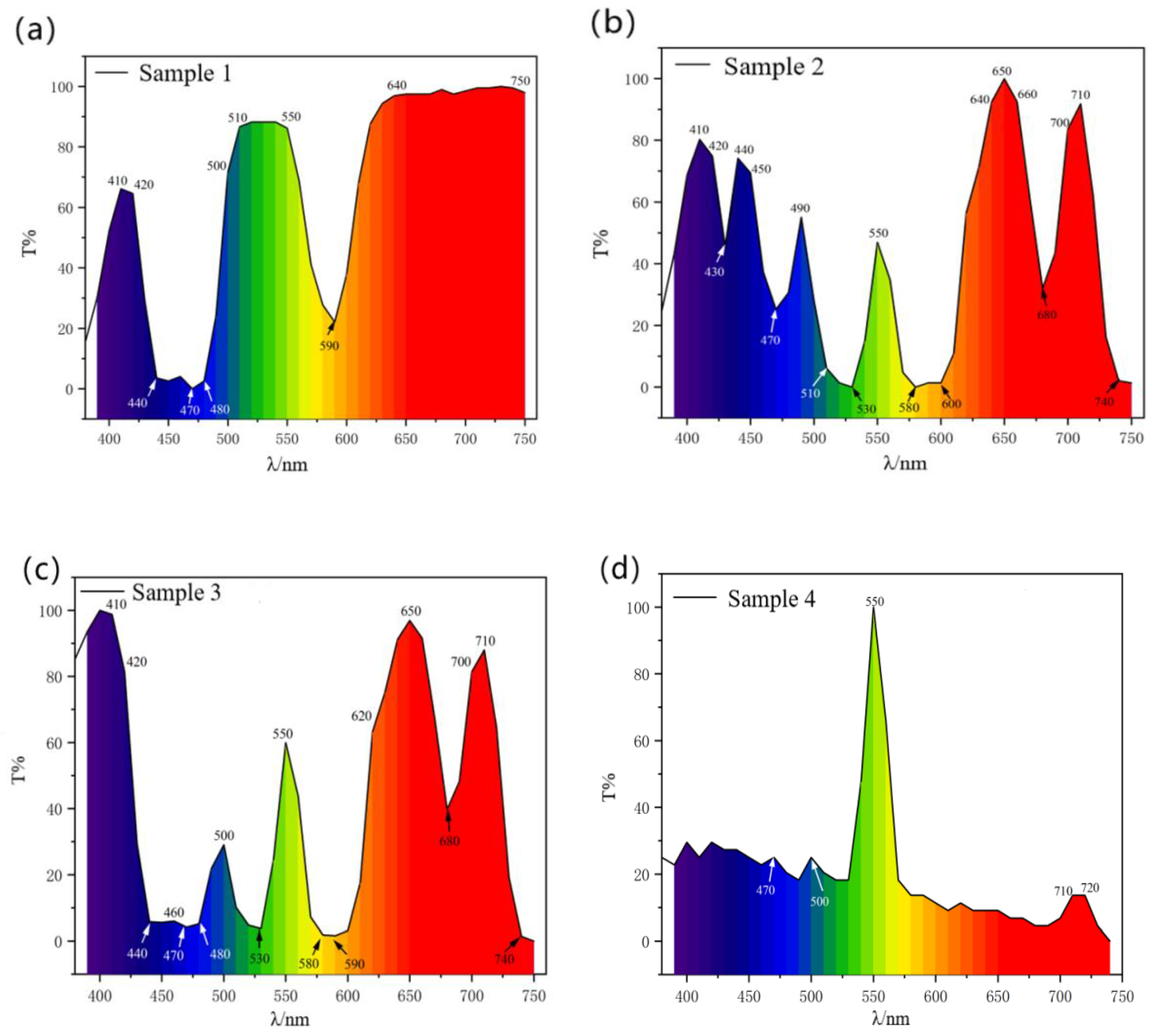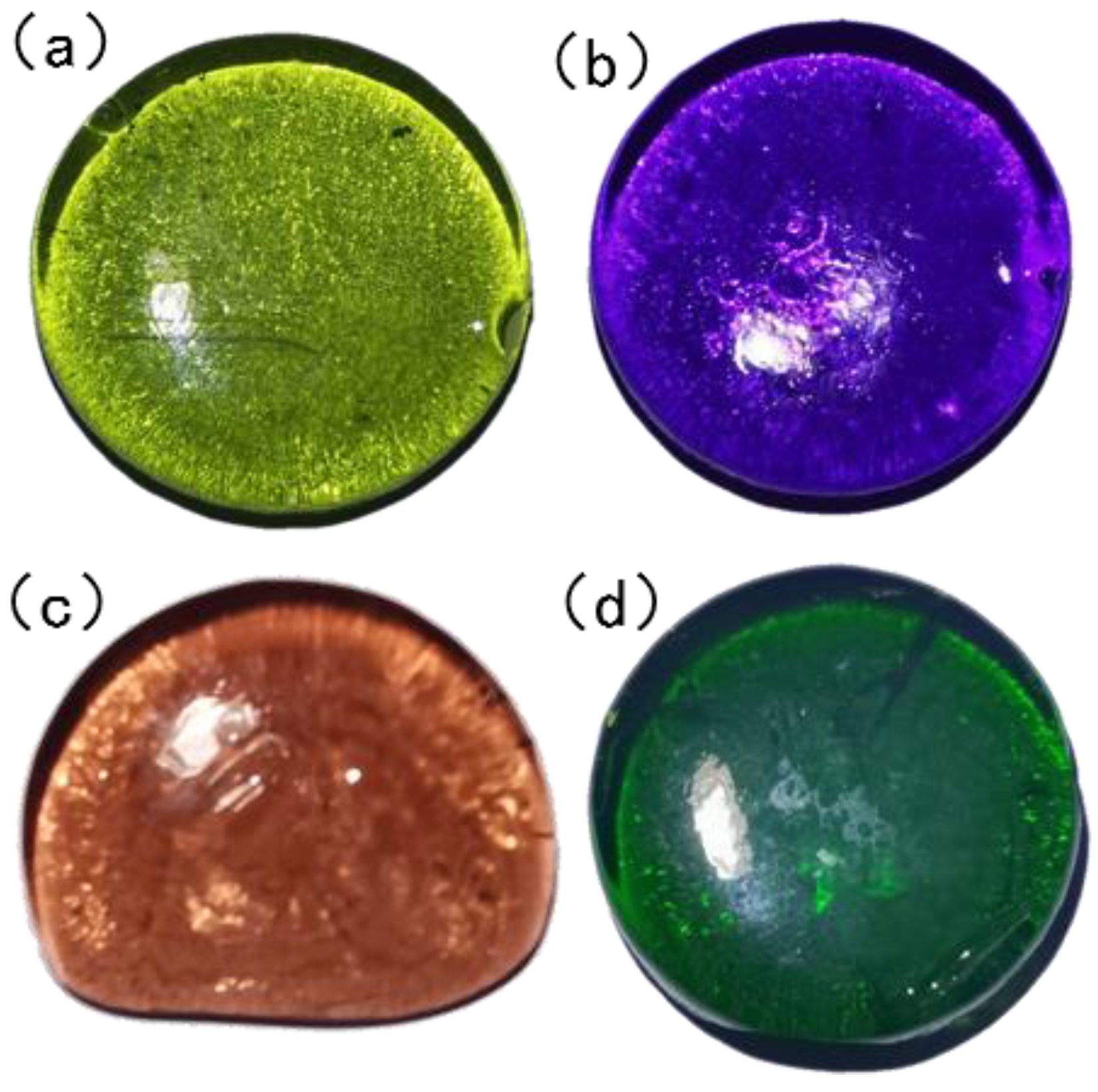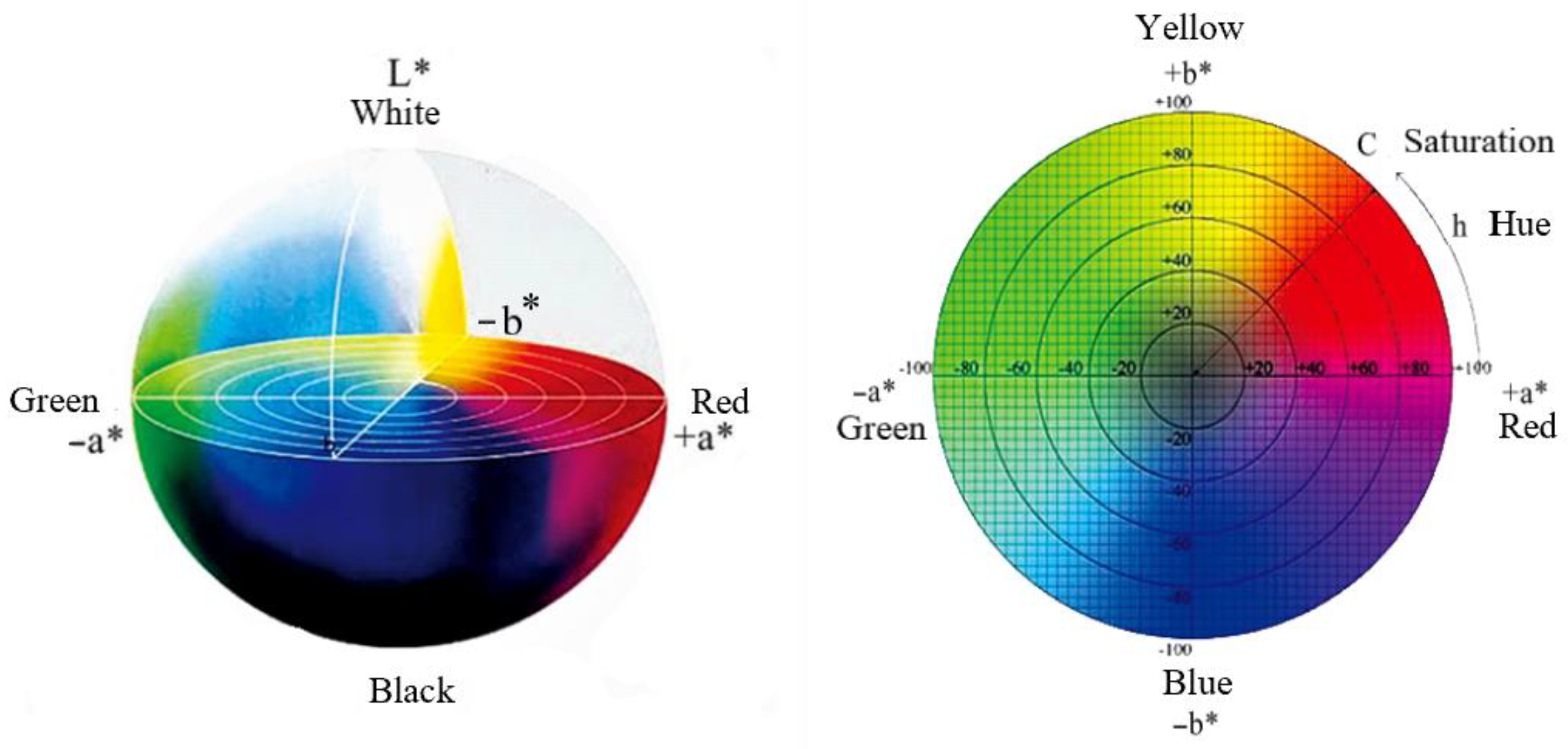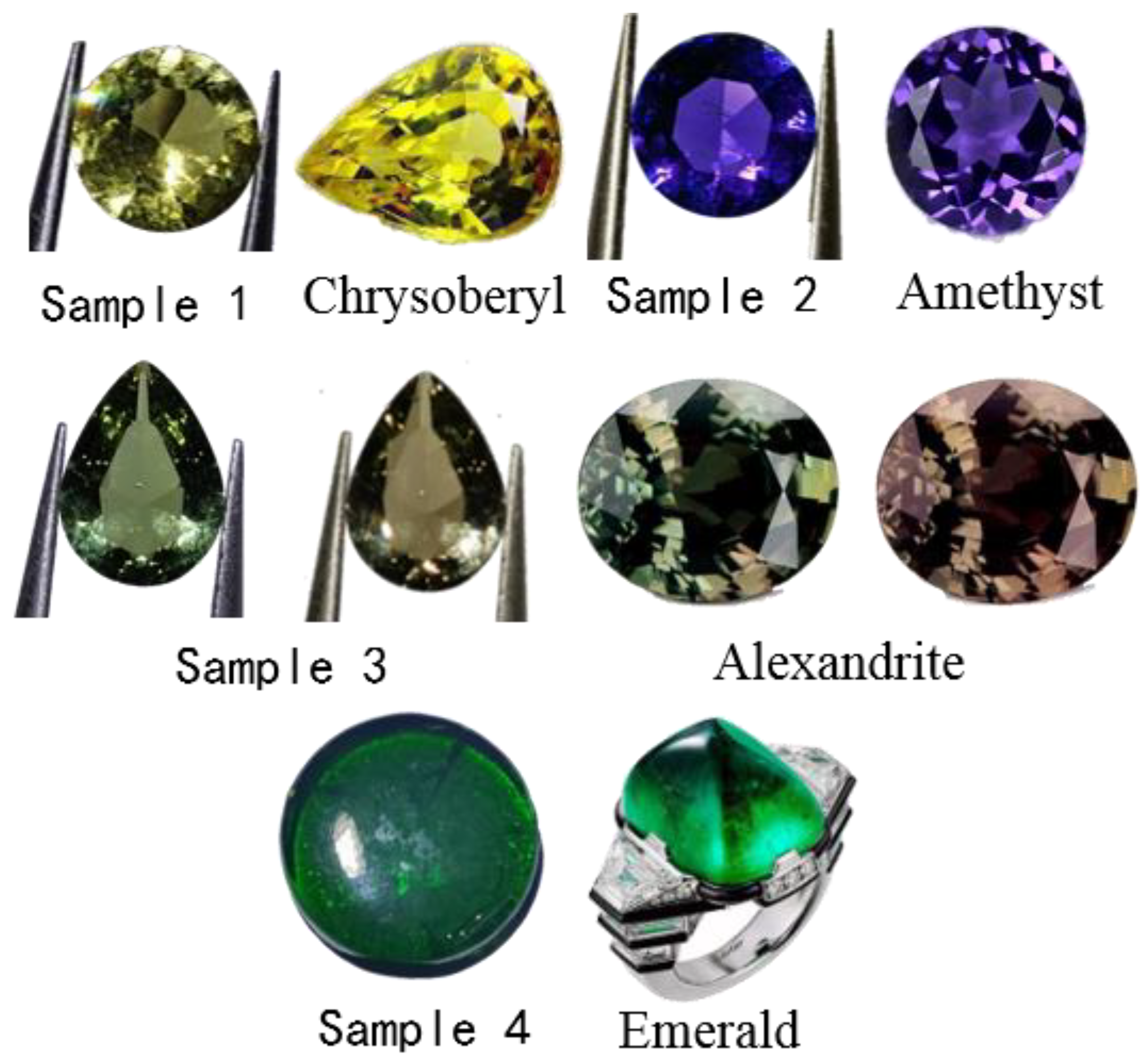Preparation and Basic Properties of Praseodymium-Neodymium-Chromium Containing Imitation Gemstone Glass
Abstract
:1. Introduction
2. Raw Materials and Methods
2.1. Experimental Raw Materials and Proportions
2.1.1. Preparation Process
2.1.2. Characterisation of Imitation Gemstone Glass Properties
3. Results
3.1. Study of Basic Physical Properties
3.2. Optical Performance

- x, y, z—Chromaticity coordinates.
- X, Y, Z—The stimulus values of the three primary colours.
- —Wavelength of lighting source
- —The spectral transmittance of the glass
- —5 nm or 10 nm
4. Discussion
5. Conclusions
Author Contributions
Funding
Institutional Review Board Statement
Informed Consent Statement
Data Availability Statement
Conflicts of Interest
References
- Lin, F. Gem-imitation glass. In International Jewellery Conference; China University of Geosciences: Wuhan, China, 2012; pp. 396–398. [Google Scholar]
- Xu, Z.; Xi, X. Study on Gemmological Characteristics of a New Type of Glass a Kind of Imitative Nephrite. J. Gems Gemol. 2012, 14, 2–3. [Google Scholar]
- Wang, C.; Tao, Y. The Artistic Glass and Decorative Glass (II). Glass Enamel 2007, 35, 53–57. [Google Scholar]
- Wang, C.; Tao, Y. The Artistic Glass and Decorative Glass (III). Glass Enamel 2007, 35, 44–48. [Google Scholar]
- Zamora, E.L.; Moliner, C.D. Gold and its manipulation across medieval treatises. Divers. Artibus 2013, 3, 5. [Google Scholar]
- Johnson, J.R. Stained Glass and Imitation Gem. Art Bull. 1957, 39, 221–224. [Google Scholar] [CrossRef]
- Shen, C. Chromogenic elements, refractive index and density of different colored “rare earth glass” gemstones. China Gems Jades 2005, 3, 97. [Google Scholar]
- Huang, W. Several problems of praseodymium-containing raw materials and other oxides of rare earth elements as glass colorants. Glass Enamel 1979, 1, 51–53. [Google Scholar]
- Shen, D.; Wang, K.; Park, J.; Chen, Y. Study of chromium in aluminoborate glass. J. Silic. 1987, 15, 214–222. [Google Scholar]
- Zhao, Y. The construction and image quality of medium telephoto lens. Astron. Enthus. 2001, 1, 4. [Google Scholar]
- Gao, S.; Li, X. Study on rare earth polychromatic gemstone glass. J. Qiqihar Light Ind. Inst. 1991, 7, 1–8. [Google Scholar]
- Zhao, J.; Liu, H.; Tang, W. The coloring effect of rare earth elements in gemstone glass. J. Qiqihar Univ. 1999, 15, 1–4. [Google Scholar]
- Yu, X.; Guo, B.; Jiang, X. Study on Color-change Synthetic Glass as Zultanite (Colour-change Disspore from Turkey) Imitation. In Proceedings of the China International Jewelry Academic Exchange Conference, Beijing, China, 7–8 November 2017. [Google Scholar]
- Zhou, D.Y.; Lu, T.J.; Ke, J. Study on the Spectral Characteristics and the Alexandrite Effect of Diaspore. Spectrosc. Spectr. Anal. 2017, 37, 3504–3509. [Google Scholar]
- Zhang, S. Spectroscopy of Rare Earth Ions. J. Anal. Chem. 2008, 9, 77–100. [Google Scholar]
- Ghose, S. Mineralogical Applications of Crystal Field Theory; Cambridge University Press: Cambridge, UK, 1970. [Google Scholar]
- Schmetzer, K.; Caucia, F.; Gilg, H.A. Chrysoberyl from the New England Placer Deposits, New South Wales, Australia. Gems Gemol. 2016, 52, 18–36. [Google Scholar] [CrossRef]
- Schmetzer, K.; Williams, B. Gem-Quality Amethyst from Rwanda: Optical and Microscopic Properties. J. Gemmol. 2018, 36, 26. [Google Scholar] [CrossRef]
- Weeramongkhonlert, V. Dramatic Color Zoning in Alexandrite. Gems Gemol. 2020, 56, 3. [Google Scholar]
- Gübelin, E.J. Gemstones of Pakistan: Emerald, Ruby, and Spinel. Gems Gemol. 1982, 18, 123–139. [Google Scholar] [CrossRef]
- Chen, F.; Wu, L.; Zhao, E. Introduction to Color Glass; Chemical Industry Press: Beijing, China, 2009. [Google Scholar]







| Glass Name | SiO2 | K2CO3 | NaNO3 | Pr6O11 | Nd2O3 | Cr2O3 | Na2B4O7·10H2O | Al2O3 | ZnO |
|---|---|---|---|---|---|---|---|---|---|
| 1 Chrysoberyl-imitation glass | 56 | 11 | 25 | 0.35 | 0 | 0 | 1.30 | 4 | 1 |
| 2 Amethyst-imitation glass | 56 | 11 | 25 | 0 | 1.90 | 0 | 1.30 | 4 | 1 |
| 3 Alexandrite-imitation glass | 56 | 11 | 25 | 0.35 | 1.90 | 0 | 1.30 | 4 | 1 |
| 4 Emerald-imitation glass | 56 | 11 | 25 | 0.35 | 1.90 | 0.50 | 1.30 | 4 | 1 |
| Sample | Colour | Refractive Index | Density ρ(g/cm3) | UV Fluorescence | ||
|---|---|---|---|---|---|---|
| D65 (6500 K) | A (2856 K) | LW 365 nm | SW 253.7 nm | |||
| 1 | Yellow | 1.52 | 2.699 | Weak (violet-red) | None | |
| 2 | Blue-Purple | 1.54 | 2.781 | None | None | |
| 3 | Yellow Green | Brownish red | 1.56 | 2.875 | Medium (violet-red) | None |
| 4 | Green | 1.55 | 2.871 | Medium (violet-red) (violet)Red | None | |
| Sample | Chromaticity Coordinates (6500 K) | Chromaticity Coordinates (2856 K) | ||||
|---|---|---|---|---|---|---|
| R | G | B | R | G | B | |
| 1 | 39.8% | 47.6% | 12.6% | 39.8% | 47.6% | 12.6% |
| 2 | 29.8% | 22.3% | 47.9% | 29.8% | 22.3% | 47.9% |
| 3 | 37.3% | 38.2% | 24.5% | 44.5% | 33.6% | 21.9% |
| 4 | 25.7% | 40.9% | 33.4% | 25.7% | 40.9% | 33.4% |
| Sample | Light Source | L* | a* | b* | C* | h0 (°) | h0 (°) |
|---|---|---|---|---|---|---|---|
| 1 | D65 | 18.88 | −3.54 | 7.62 | 8.40 | 114.89 | 17.35 |
| A | 15.05 | −1.23 | 9.28 | 9.36 | 97.54 | ||
| 2 | D65 | 23.32 | 2.03 | −2.54 | 3.25 | 308.68 | 10.71 |
| A | 14.32 | 2.27 | −4.27 | 4.84 | 297.97 | ||
| 3 | D65 | 14.07 | −7.20 | 16.18 | 17.71 | 113.99 | 45.42 |
| A | 9.70 | 3.86 | 9.83 | 10.56 | 68.57 | ||
| 4 | D65 | 3.33 | −0.29 | −0.79 | 0.84 | 250.15 | 9.76 |
| A | 3.85 | 0.73 | −1.28 | 1.48 | 240.39 |
Publisher’s Note: MDPI stays neutral with regard to jurisdictional claims in published maps and institutional affiliations. |
© 2022 by the authors. Licensee MDPI, Basel, Switzerland. This article is an open access article distributed under the terms and conditions of the Creative Commons Attribution (CC BY) license (https://creativecommons.org/licenses/by/4.0/).
Share and Cite
Zhang, S.; Li, K.; Pu, J.; Ni, W. Preparation and Basic Properties of Praseodymium-Neodymium-Chromium Containing Imitation Gemstone Glass. Materials 2022, 15, 7341. https://doi.org/10.3390/ma15207341
Zhang S, Li K, Pu J, Ni W. Preparation and Basic Properties of Praseodymium-Neodymium-Chromium Containing Imitation Gemstone Glass. Materials. 2022; 15(20):7341. https://doi.org/10.3390/ma15207341
Chicago/Turabian StyleZhang, Siqi, Keqing Li, Junyuan Pu, and Wen Ni. 2022. "Preparation and Basic Properties of Praseodymium-Neodymium-Chromium Containing Imitation Gemstone Glass" Materials 15, no. 20: 7341. https://doi.org/10.3390/ma15207341





